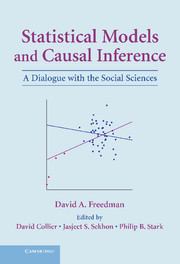24 results
Index
-
- Book:
- Statistical Models and Causal Inference
- Published online:
- 05 June 2012
- Print publication:
- 23 November 2009, pp 393-399
-
- Chapter
- Export citation
11 - Survival Analysis: An Epidemiological Hazard?
-
- Book:
- Statistical Models and Causal Inference
- Published online:
- 05 June 2012
- Print publication:
- 23 November 2009, pp 169-192
-
- Chapter
- Export citation
7 - Black Ravens, White Shoes, and Case Selection: Inference with Categorical Variables
-
- Book:
- Statistical Models and Causal Inference
- Published online:
- 05 June 2012
- Print publication:
- 23 November 2009, pp 105-114
-
- Chapter
- Export citation
Frontmatter
-
- Book:
- Statistical Models and Causal Inference
- Published online:
- 05 June 2012
- Print publication:
- 23 November 2009, pp i-iv
-
- Chapter
- Export citation
Part IV - Shoe Leather Revisited
-
- Book:
- Statistical Models and Causal Inference
- Published online:
- 05 June 2012
- Print publication:
- 23 November 2009, pp 335-336
-
- Chapter
- Export citation
3 - Statistical Models and Shoe Leather
-
- Book:
- Statistical Models and Causal Inference
- Published online:
- 05 June 2012
- Print publication:
- 23 November 2009, pp 45-62
-
- Chapter
- Export citation
8 - What is the Chance of an Earthquake?
-
-
- Book:
- Statistical Models and Causal Inference
- Published online:
- 05 June 2012
- Print publication:
- 23 November 2009, pp 115-130
-
- Chapter
- Export citation
17 - On the So-Called “Huber Sandwich Estimator” and “Robust Standard Errors”
-
- Book:
- Statistical Models and Causal Inference
- Published online:
- 05 June 2012
- Print publication:
- 23 November 2009, pp 295-304
-
- Chapter
- Export citation
10 - The Swine Flu Vaccine and Guillain-Barré Syndrome: A Case Study in Relative Risk and Specific Causation
-
-
- Book:
- Statistical Models and Causal Inference
- Published online:
- 05 June 2012
- Print publication:
- 23 November 2009, pp 151-168
-
- Chapter
- Export citation
1 - Issues in the Foundations of Statistics: Probability and Statistical Models
-
- Book:
- Statistical Models and Causal Inference
- Published online:
- 05 June 2012
- Print publication:
- 23 November 2009, pp 3-22
-
- Chapter
- Export citation
12 - On Regression Adjustments in Experiments with Several Treatments
-
- Book:
- Statistical Models and Causal Inference
- Published online:
- 05 June 2012
- Print publication:
- 23 November 2009, pp 195-218
-
- Chapter
- Export citation
References and Further Reading
-
- Book:
- Statistical Models and Causal Inference
- Published online:
- 05 June 2012
- Print publication:
- 23 November 2009, pp 357-392
-
- Chapter
- Export citation

Statistical Models and Causal Inference
- A Dialogue with the Social Sciences
-
- Published online:
- 05 June 2012
- Print publication:
- 23 November 2009
Editors' Introduction: Inference and Shoe Leather
-
-
- Book:
- Statistical Models and Causal Inference
- Published online:
- 05 June 2012
- Print publication:
- 23 November 2009, pp xiii-xvi
-
- Chapter
- Export citation
Part I - Statistical Modeling: Foundations and Limitations
-
- Book:
- Statistical Models and Causal Inference
- Published online:
- 05 June 2012
- Print publication:
- 23 November 2009, pp 1-2
-
- Chapter
- Export citation
Part III - New Developments: Progress or Regress?
-
- Book:
- Statistical Models and Causal Inference
- Published online:
- 05 June 2012
- Print publication:
- 23 November 2009, pp 193-194
-
- Chapter
- Export citation
Part II - Studies in Political Science, Public Policy, and Epidemiology
-
- Book:
- Statistical Models and Causal Inference
- Published online:
- 05 June 2012
- Print publication:
- 23 November 2009, pp 63-64
-
- Chapter
- Export citation
13 - Randomization Does Not Justify Logistic Regression
-
- Book:
- Statistical Models and Causal Inference
- Published online:
- 05 June 2012
- Print publication:
- 23 November 2009, pp 219-242
-
- Chapter
- Export citation
Preface
-
-
- Book:
- Statistical Models and Causal Inference
- Published online:
- 05 June 2012
- Print publication:
- 23 November 2009, pp xi-xii
-
- Chapter
- Export citation
Contents
-
- Book:
- Statistical Models and Causal Inference
- Published online:
- 05 June 2012
- Print publication:
- 23 November 2009, pp v-x
-
- Chapter
- Export citation



